
1900-1905 NYC: A Transformative Era of Urban Development & The IRT Subway System
The early 1900s, particularly from 1900 to 1905, marked a transformative phase in New York City’s history, characterized by rapid urban development and significant cultural evolution. This era laid the groundwork for New York City’s rise as a global metropolis. A pivotal event during this time was the inauguration of the New York City Subway in 1904, revolutionizing urban transportation and unifying the city in unprecedented ways.
Architecturally, this period saw the construction of iconic structures that would define New York City’s skyline. The Flatiron Building, completed in 1902, became an architectural landmark, symbolizing the city’s innovative spirit and the dawn of the skyscraper era. These advancements in architecture were matched by a vibrant cultural scene, driven by an influx of immigrants who enriched the city’s diverse community fabric.
The onset of the 20th century introduced new challenges and opportunities for New York City, positioning it as a hub for commerce, finance, and the arts. This era also marked the beginning of significant social reforms, addressing the needs of the growing working class and paving the way for progressive movements in the decades to come.
In summary, the early 1900s in New York City were a time of dynamic change, establishing a foundation for the city’s rapid growth and evolution throughout the 20th century. The development of its infrastructure, architecture, and social framework during these years was crucial in shaping New York City’s unique character, making this era an integral part of its rich historical narrative.
Timeline of New York City’s History 1900-1905
Discover surprising historical facts about The City That Never Sleeps—explore fun, educational insights into its history, population, iconic landmarks, and more, perfect for students, history enthusiasts, and anyone curious about NYC’s rich heritage.
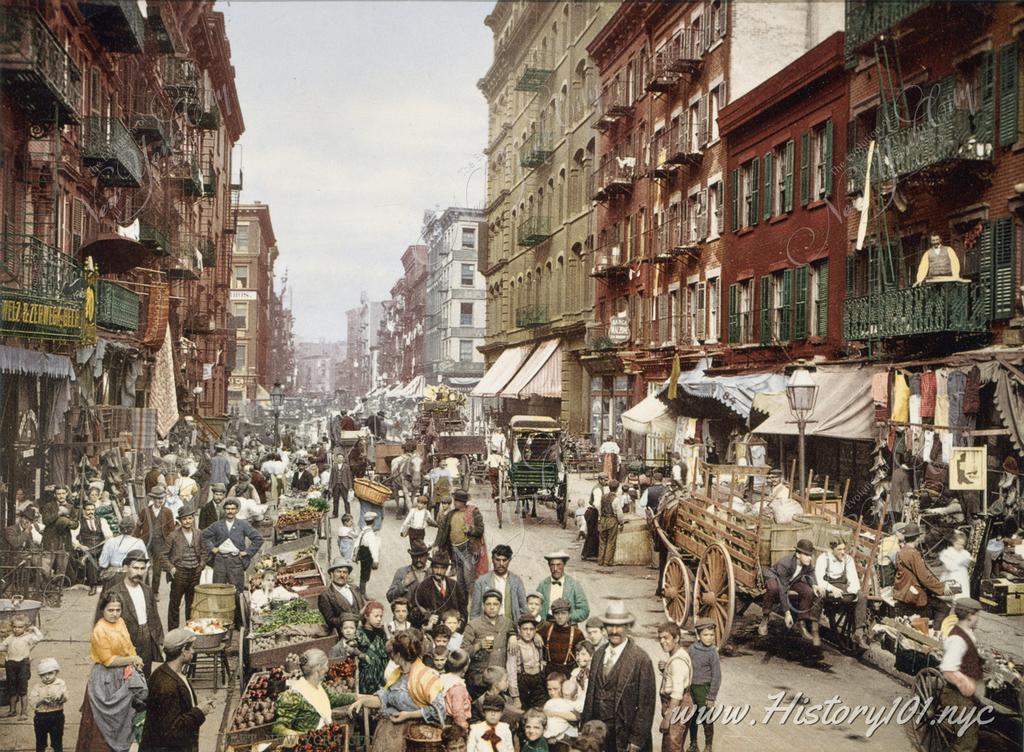
1900: Mulberry Street Markets: A Glimpse into NYC's Vibrant Commerce
Explore 1900 NYC life in Mulberry Street Markets' photo, capturing the essence of local trade and vibrant street culture
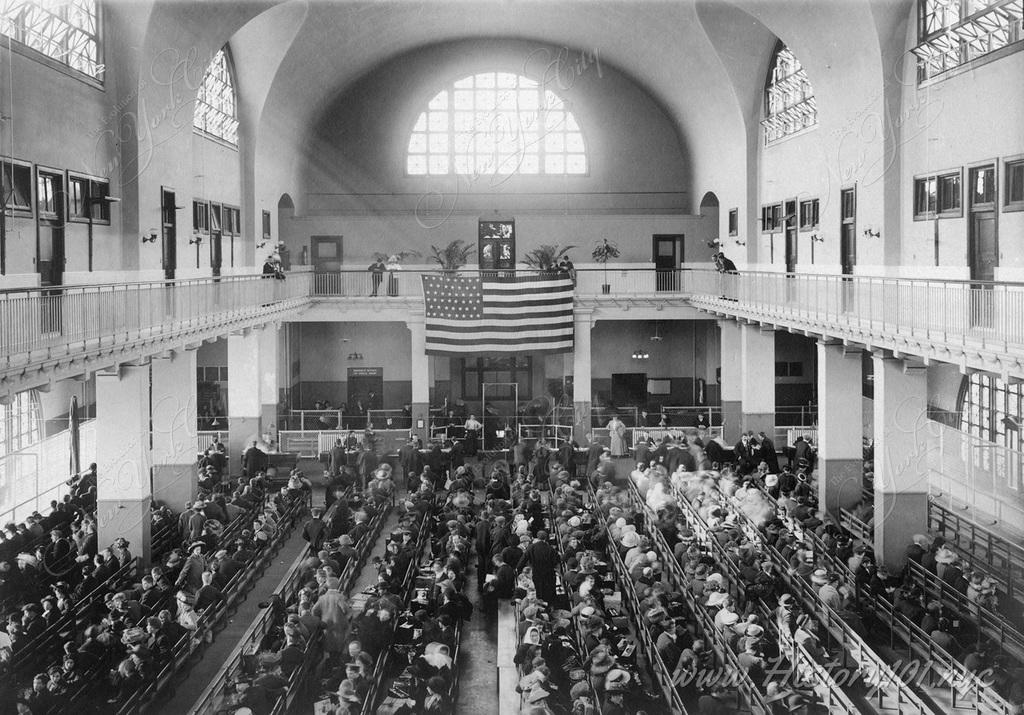
1902: Ellis Island: Inside the Main Hall of America's Immigrant Story
Explore the 1902 Main Hall at Ellis Island, capturing NYC's pivotal role in the immigrant journey and shaping its cultural diversity
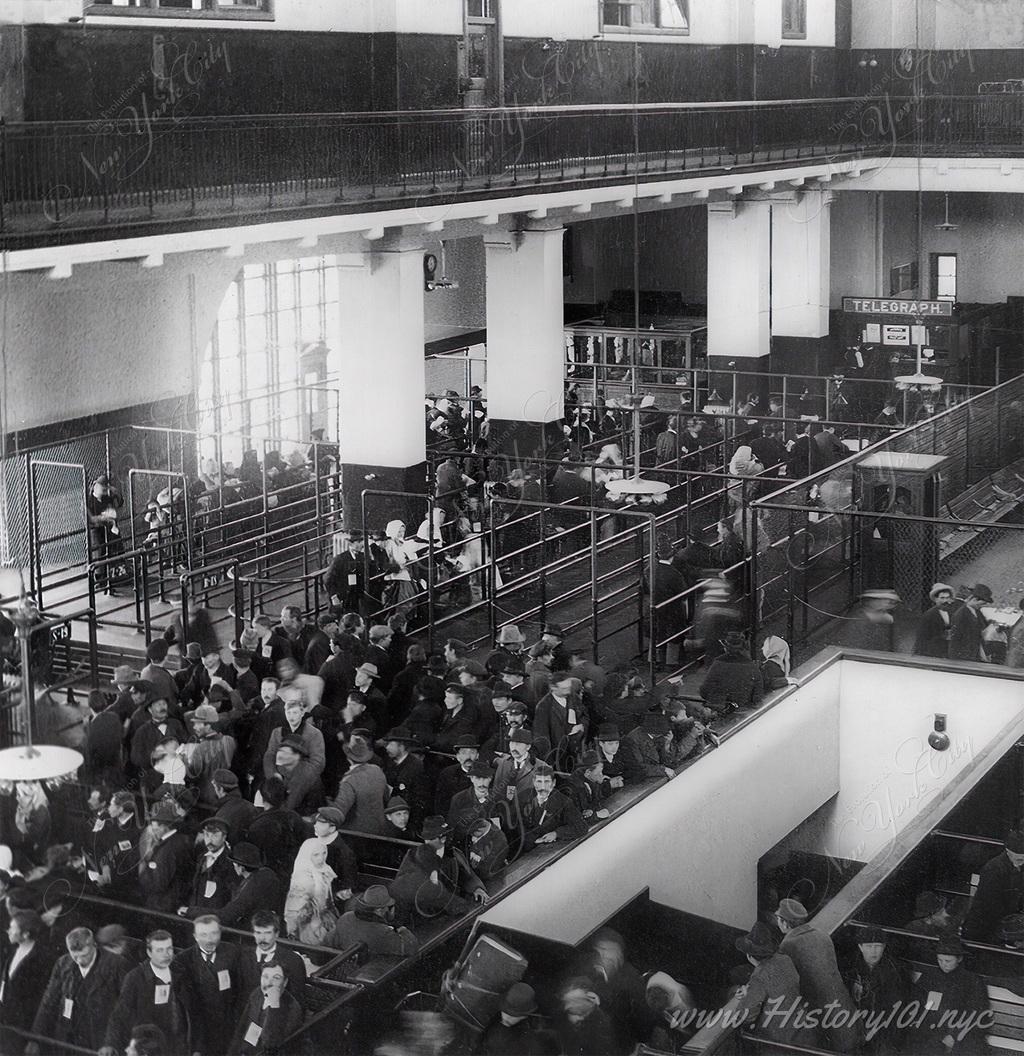
1904: Immigrants at Ellis Island, New York Harbor
Immigrants waiting to be processed at Ellis Island. New York had become a Wonder City and beacon of hope for people all over the world.
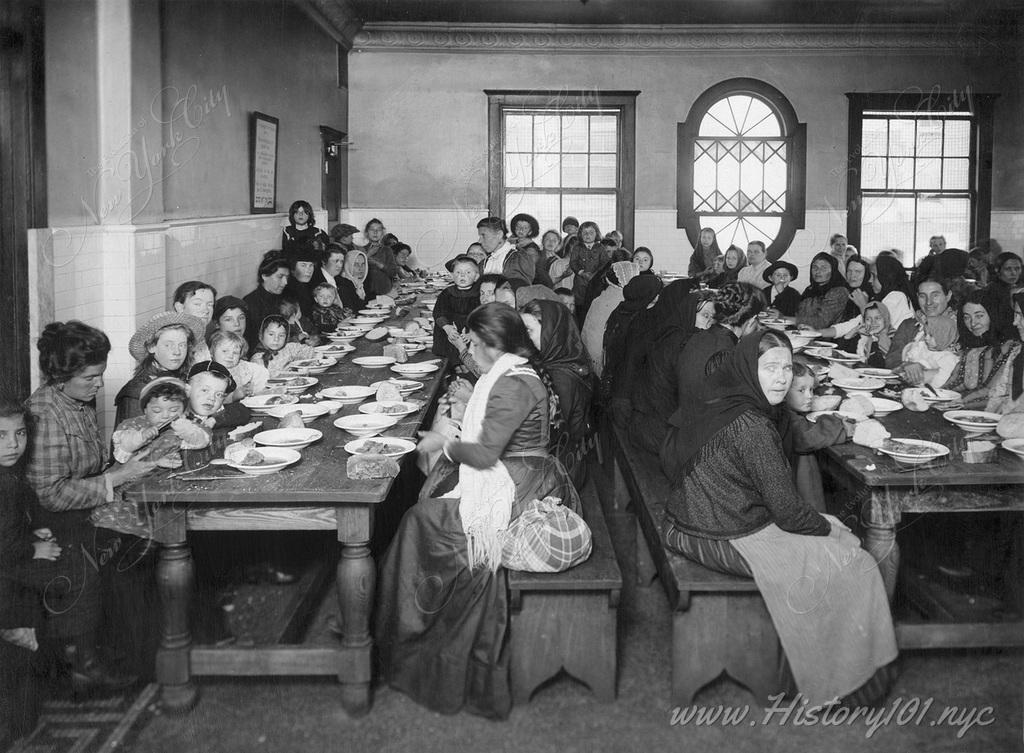
1902: Ellis Island: A Snapshot of New Starts in New York
Explore the 1902 Ellis Island photo capturing the immigrant experience and NYC's role as America's welcoming port
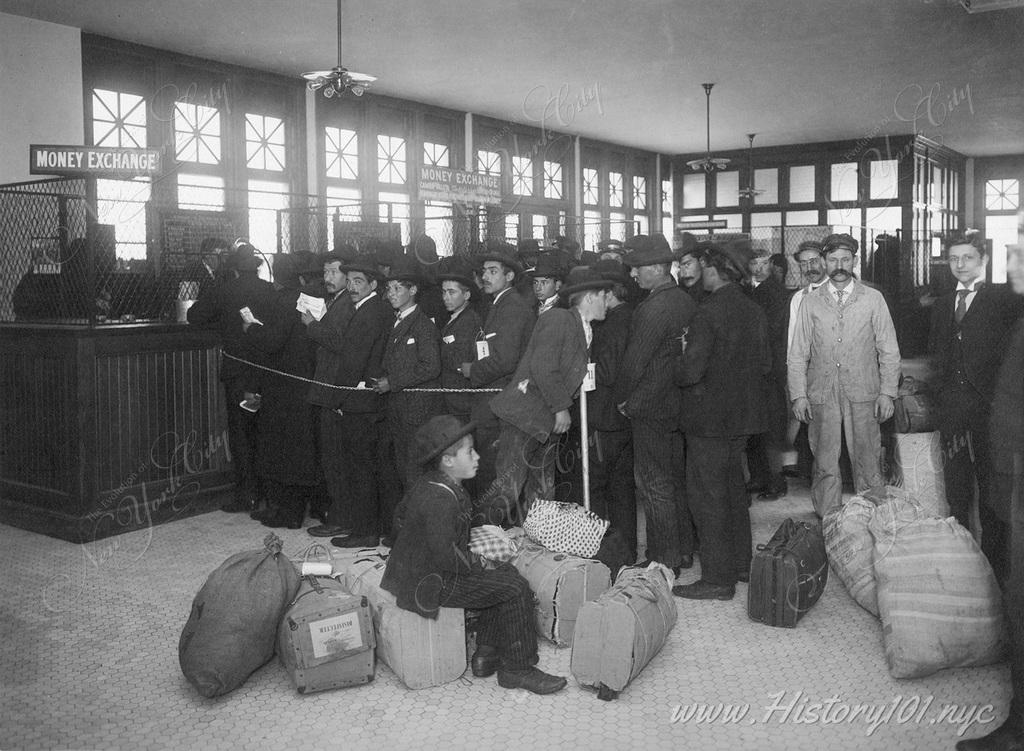
1902: Money Exchange at Ellis Island's Immigrant Station
Immigrants ready for travel with baggages lined up at teller's windows marked money exchange.
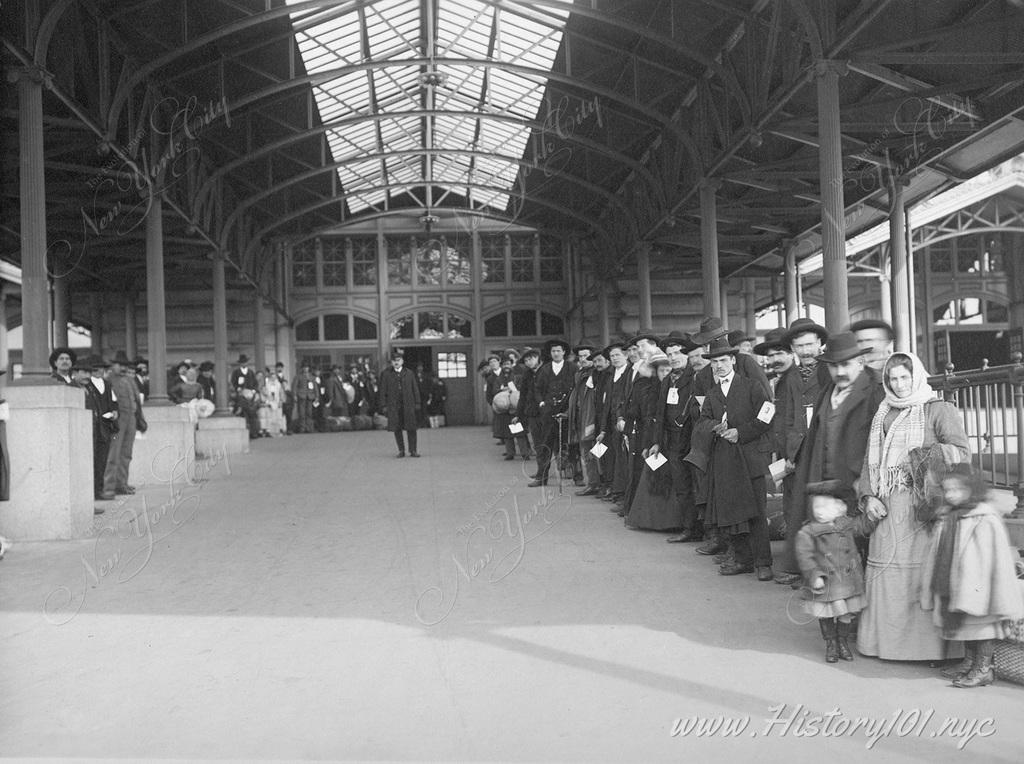
1902: Ellis Island Immigrants Bound For Manhattan
A line of immigrants has passed all phases of inspection at Ellis Island and await the ferry to Manhattan where they will begin their new lives.
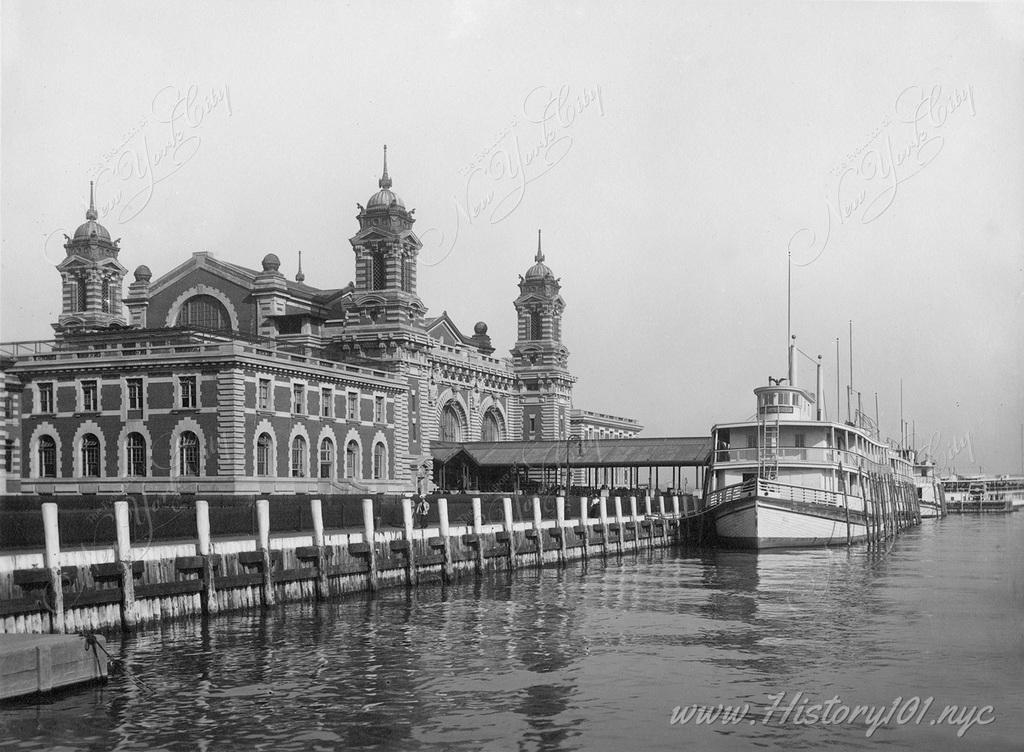
1902: Immigrant Station at Ellis Island
An exterior perspective of Immigration Station at Ellis Island, with ferry docked at the adjacent pier.
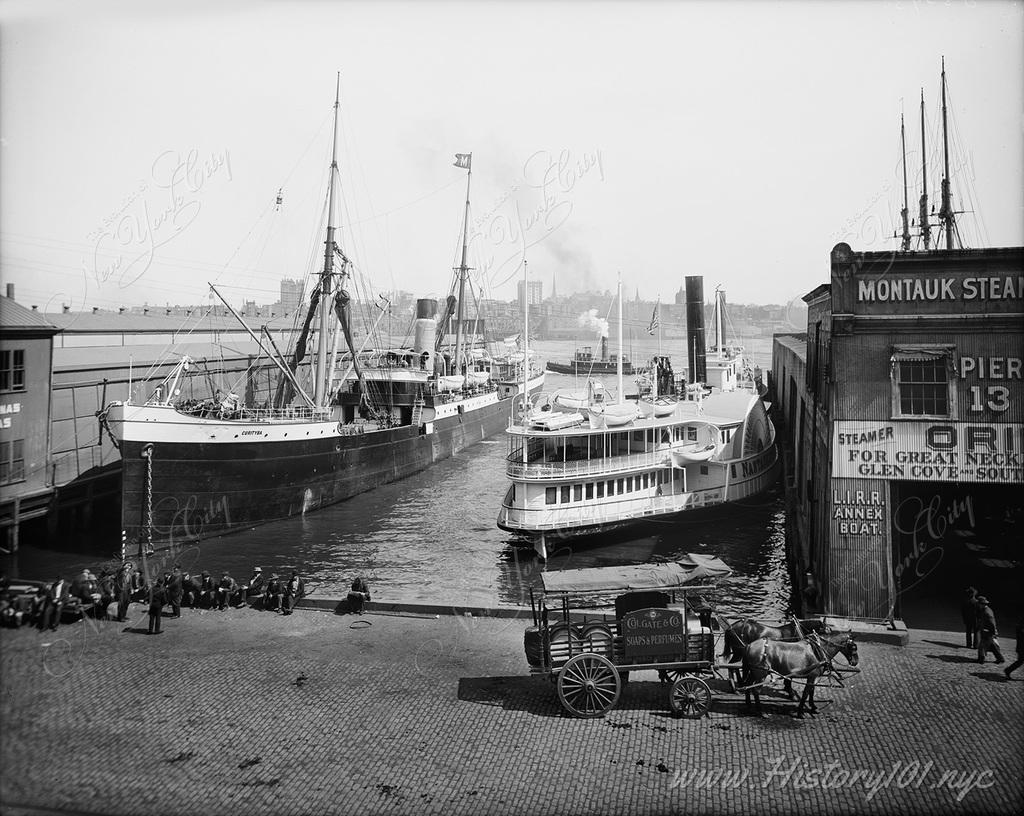
1900: Piers at the Foot of Wall Street
A photograph of the piers at Wall Street with two large boats docked and a Colgate carriage with horses parked on the promenade.
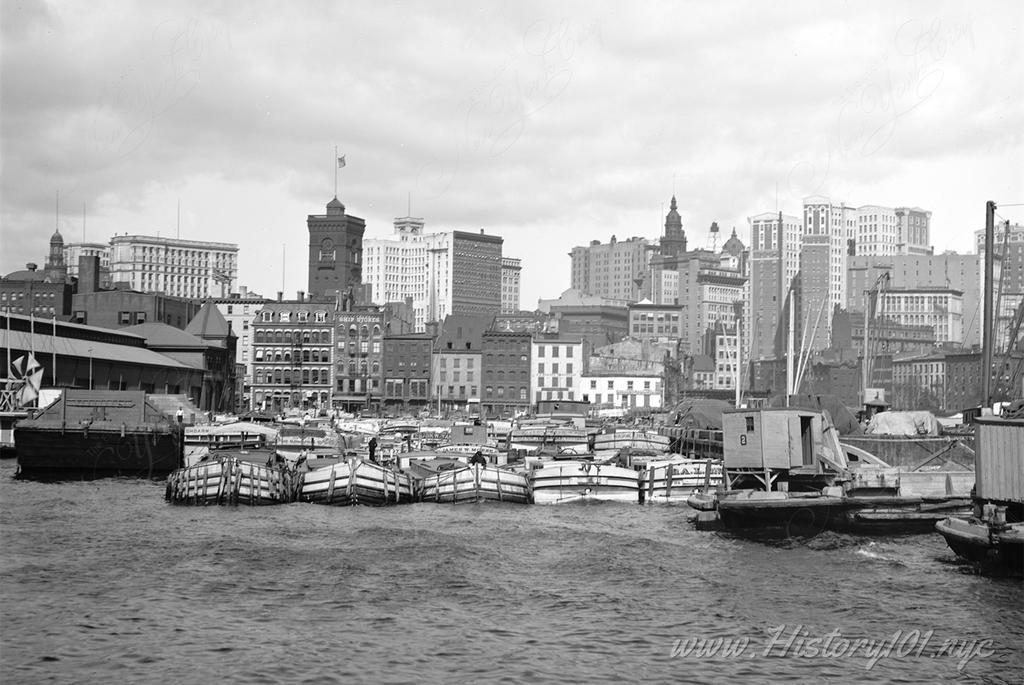
1900: East River Docks
Photograph of canal boats at the East River docks with Manhattan's downtown skyline in the background.
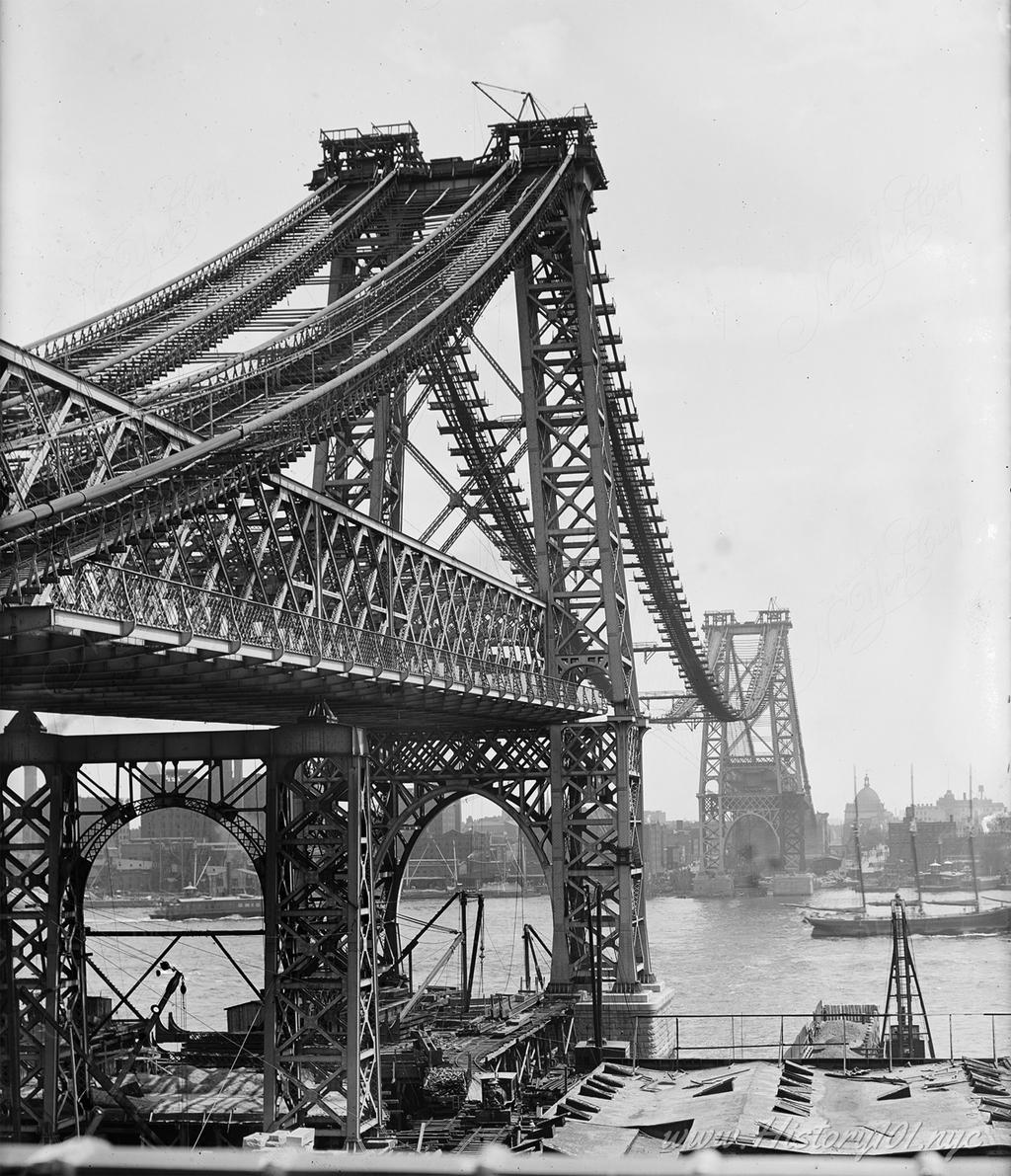
1900: Williamsburg Bridge Construction
Photograph of a growing Williamsburg Bridge, spanning the East River and facing Brooklyn.
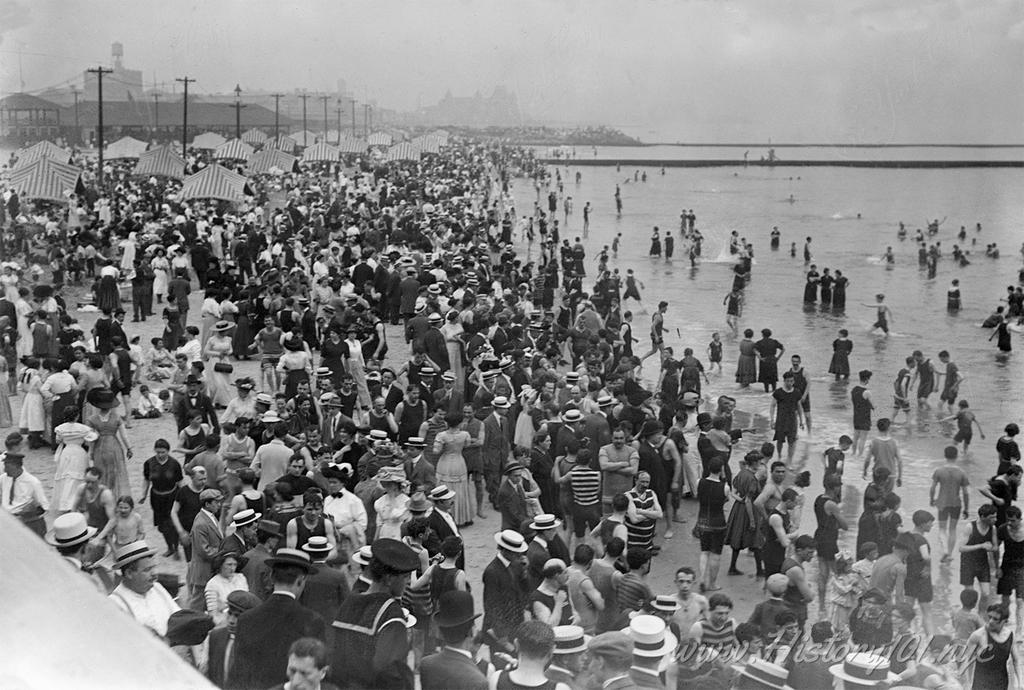
1900: Coney Island Beach
Photograph of crowds celebrating the Fourth of July on the shores of Coney Island.
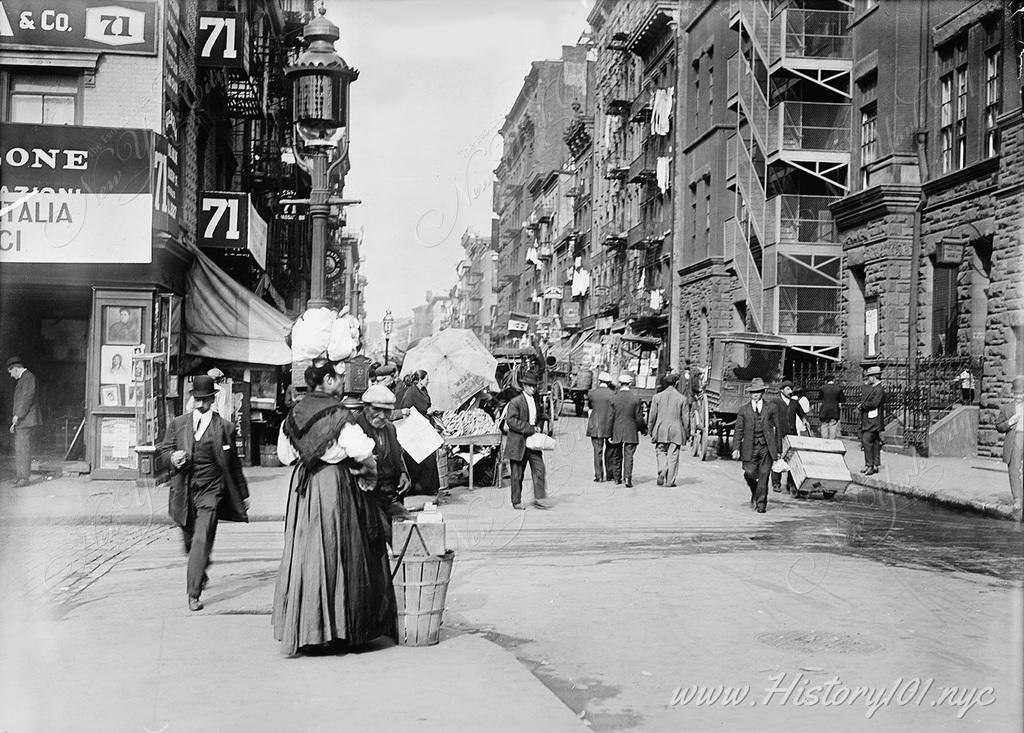
1900: Mulberry Street in Little Italy
A picture of pedestrians on Mulberry Street, located in the heart of a bustling Italian neighborhood.
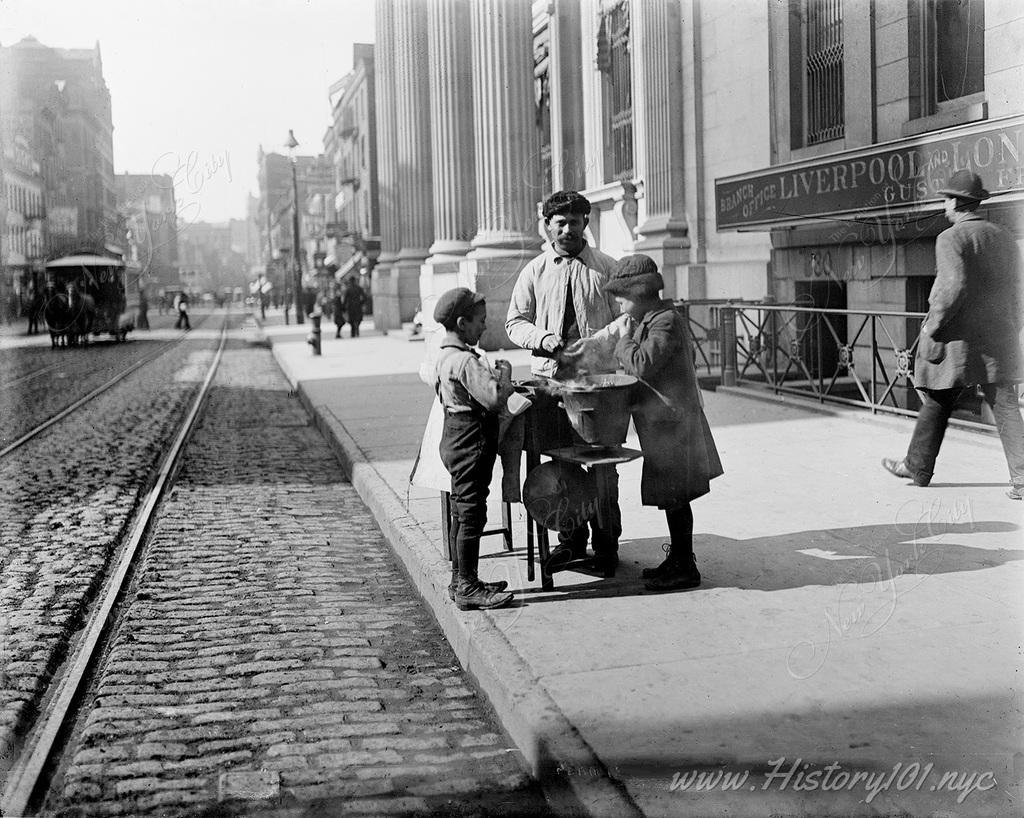
1900: Peanut Stand at West 42nd Street
Children purchasing snacks from a street vendor on West 42nd Street.
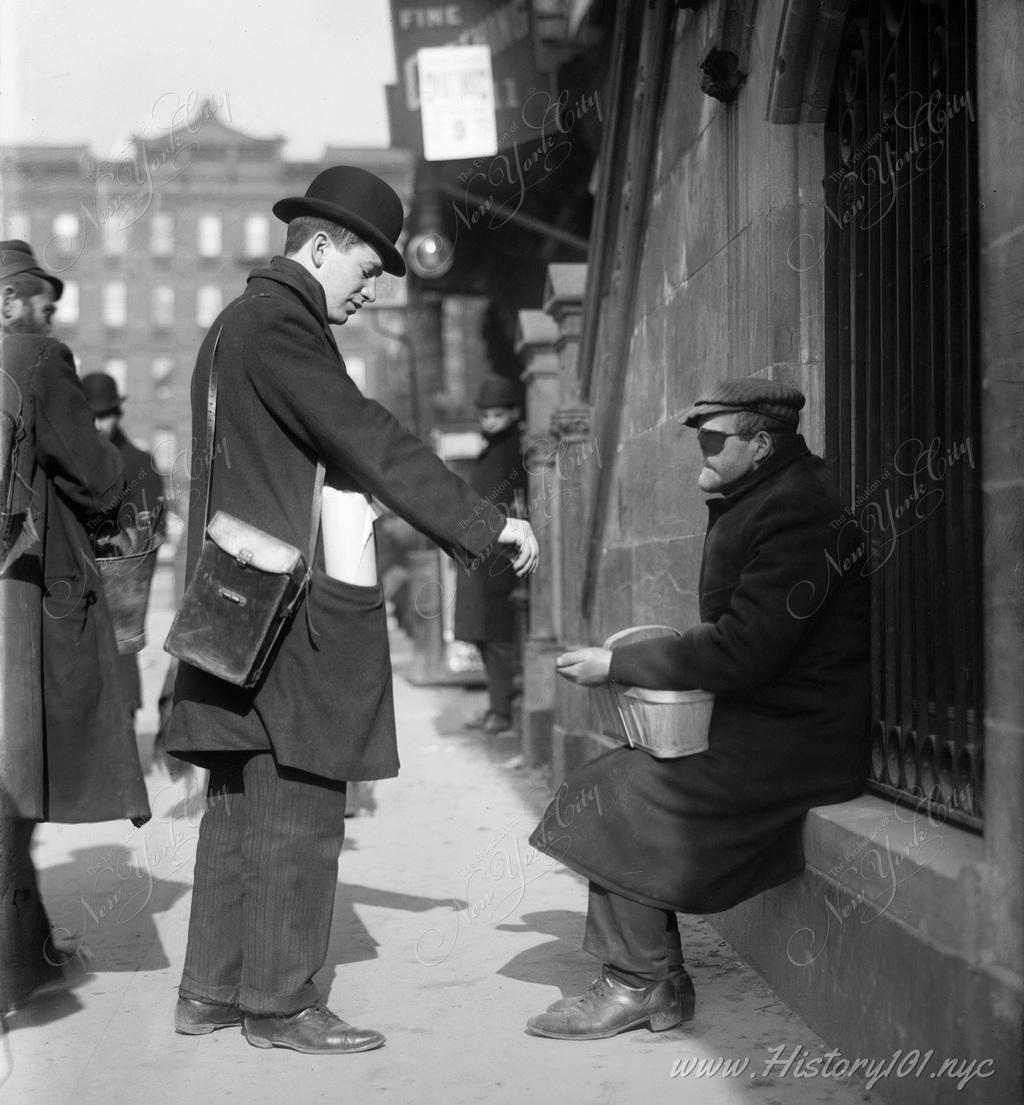
1901: Man Asking for Spare Change
A man with an eyepatch and facial scars asking for spare change from a passing pedestrian.
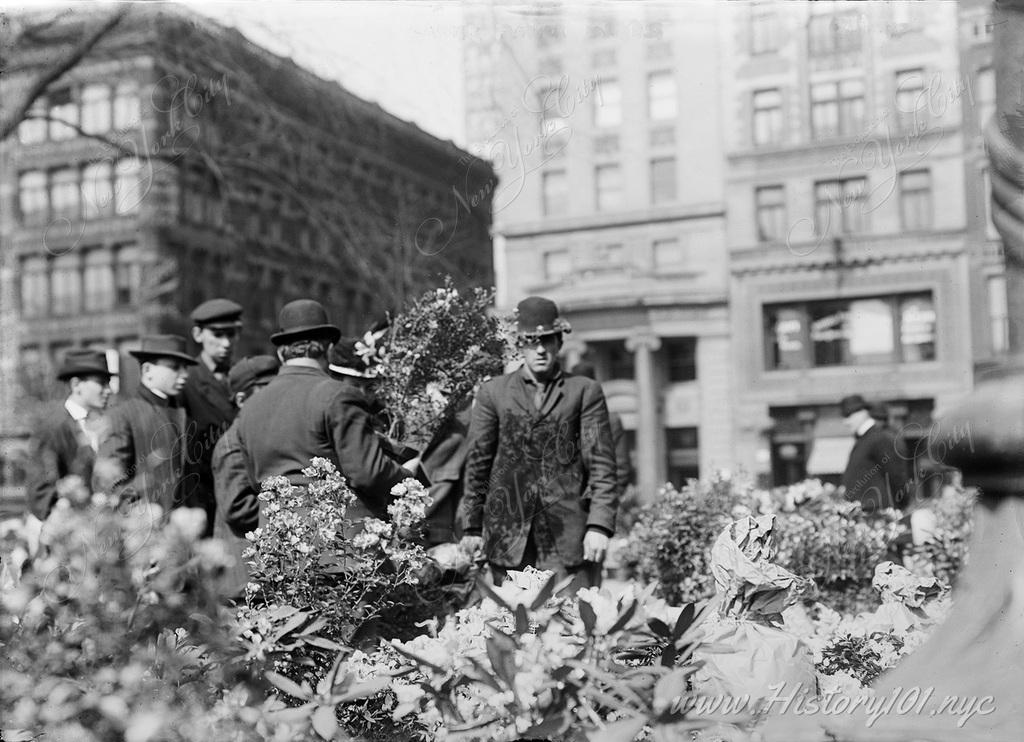
1900: Easter Flower Market on Union Square
Photograph of a man selling flowers to customers, framed by large bouquets against the iconic backdrop of the surrounding buildings.
Timeline of New York City: 1900-1905
1900: New York City experienced a pivotal moment in its development following the historic 1898 consolidation, which united Manhattan, Brooklyn, Queens, The Bronx, and Staten Island into one comprehensive entity. By the year 1900, the city's population had surged to 3,437,202 according to the U.S. Census. This significant increase was not solely a growth in numbers but also an expansion in the geographic and administrative boundaries of the city, marking a key transition in its evolution into a modern metropolis. The consolidation significantly altered the landscape of New York City, enabling it to integrate and utilize its expanded territory more effectively, setting the stage for dramatic transformations in its urban and cultural fabric.
The consolidation of New York City in 1898, reflected by the 1900 census, marked a transformative era in its history, significantly enhancing its governance capabilities. This unification allowed for more coordinated and efficient management across the newly formed boroughs, improving infrastructure development, service delivery, and overall city planning. As a unified entity, New York City was better positioned to leverage its resources, cater to the diverse needs of its rapidly growing population, and strategically plan for its future. This crucial period of adjustment laid the foundational stones for what would become a thriving global urban center, guiding New York City's journey towards becoming a symbol of innovation and a beacon of cultural diversity.
1900: Mayor Robert Anderson Van Wyck ceremoniously broke ground for the new "Rapid Transit Railroad" in New York City, on March 24, marking a pivotal moment in the city’s transportation history. This event initiated the construction of what would eventually evolve into an extensive subway system, aimed at revolutionizing travel between Manhattan and Brooklyn. The project was conceived in response to the burgeoning needs of New York’s rapidly increasing population and its expanding urban landscape. This significant development was set to enhance the city's infrastructure and meet the rising demand for more efficient transportation solutions across the bustling metropolis.
The construction of the subway system represented a monumental advancement in urban planning and development, providing faster and more reliable travel options for millions of residents and visitors. Its role was crucial in economically and socially integrating Manhattan and Brooklyn, thereby boosting the overall connectivity within New York City. The subway not only simplified daily commutes but also underscored New York’s capacity to execute large-scale infrastructure projects. This endeavor significantly bolstered the city's image as a progressive, forward-thinking urban center, capable of meeting the complex needs of its diverse and expanding population through innovative transportation solutions.
1900: The Associated Press (AP) was formally organized as a nonprofit news cooperative in New York City, setting a foundational stone for modern news distribution. This organization, established by newspapers seeking to optimize the sharing and dissemination of news content, revolutionized how news was gathered and reported. The AP's innovative cooperative model allowed its member newspapers to share the costs of news gathering and ensured rapid distribution of news content across various regions, enhancing the efficiency and scope of news reporting.
On May 22, the establishment of the AP in New York City marked a significant milestone in the evolution of the media landscape. Positioned in one of the world's most influential cities, the AP contributed to New York City's reputation as a global media capital. The presence of this major news cooperative helped foster an environment of journalistic excellence and innovation, benefiting not only the local news ecosystem but also setting standards for journalistic practices worldwide. This strategic initiative not only supported the city's economic growth by creating jobs within the media sector but also enhanced the cultural and informational richness of New York City, reinforcing its status as a hub for global communication.
1900: New York City undertook the significant task of reconstructing the Spuyten Duyvil Bridge, which plays a crucial role in connecting Manhattan and the Bronx. This bridge is a key component of the city's transportation network, facilitating essential intra-regional connections that support both commuter and freight movements across the regions. The project was part of a broader initiative to modernize and expand the city’s infrastructure to meet the demands of a growing population and evolving industrial landscape.
The reconstruction of the Spuyten Duyvil Bridge reflected New York City's commitment to infrastructural modernization at the turn of the 20th century. This effort was crucial for bolstering economic growth and improving connectivity, showcasing the city's proactive approach to enhancing its urban infrastructure. By investing in such critical projects, New York City aimed to ensure that its transportation network could accommodate future growth and continue to serve as a vital link for residents and businesses alike.
1900: The International Ladies' Garment Workers' Union (ILGWU) emerged as a pivotal force in New York City's labor history, advocating vigorously for improved labor standards, particularly for women and immigrants within the bustling garment industry. The establishment of this union marked a significant turning point, aligning with a broader era of transformation where labor rights were increasingly recognized as essential for equitable workplaces. The ILGWU's activism highlighted the pressing need for fair employment practices and became a cornerstone of the U.S. labor rights movement, reflecting the era's growing demand for social and economic justice.
The influence of the ILGWU extended well beyond the improvement of working conditions and wage enhancements; it played a crucial role in advancing broader social justice issues and labor rights across the city and nation. Through its relentless efforts, the union was instrumental in spearheading significant labor law reforms, establishing New York City as a forefront of progressive labor policy. These reforms not only reshaped the city's economic and social landscapes but also solidified its status as a leading influence in national labor relations. The legacy of the ILGWU continues to impact labor movements and policies, underscoring the profound role such organizations can play in transforming society.
1900: The first U.S. automobile show, a landmark event for the burgeoning automotive industry, was held at Madison Square Garden in New York City. This exhibition, showcasing the latest in automotive technology and design, provided an early platform for automobile manufacturers to present their innovations to a public eager to embrace the new mode of transportation. The show not only demonstrated the potential of the automobile as a commercial product but also served as a barometer for the industry’s future growth and its impact on society.
On November 3, this pioneering automobile show opened its doors, marking a significant moment in both the history of the automobile and New York City's evolution as a center for innovation and commerce. By hosting this event, New York City solidified its reputation as a vital hub for major events and exhibitions, drawing visitors and exhibitors from across the nation and around the world. The success of the show had a ripple effect on the local economy, boosting sectors such as hospitality and retail, and paving the way for the city to host subsequent shows and similar large-scale public events.
1901: Robert Marshall, a prominent American forester and wilderness activist, made significant contributions to environmental conservation. As a co-founder of the Wilderness Society in 1935, he played a pivotal role in advocating for the protection of natural areas across the United States. His efforts helped to establish a legacy of wilderness preservation that continues to influence conservation strategies today.
Born in New York City on January 2, Marshall's upbringing in a vibrant urban environment contrasted sharply with the wild landscapes he would later work to preserve. This juxtaposition highlights the diverse backgrounds from which environmental activism can emerge, underscoring the city's role in shaping a national leader who would leave an enduring impact on America's natural heritage. Marshall's work remains a critical part of the environmental movement, reflecting the lasting influence of his New York City roots.
1901: On September 14, Theodore "T.R." Roosevelt, Jr., became the President of the United States following the assassination of President William McKinley. Born in New York City, Roosevelt's ascent to the presidency marked him as the first American president originating from this metropolis, signaling a significant shift in the national political landscape. His rise from a New York background into the nation’s highest office highlighted the growing influence of urban centers in American politics during the early 20th century. This transition into leadership during a critical period of change set the stage for a presidency that would be characterized by vigorous reform and innovation.
Serving until 1909, Roosevelt's tenure was notable for progressive reforms that addressed the rapid economic and social changes in America, with a particular focus on conservation and urban planning—issues that resonated deeply with growing cities like New York. His leadership not only shaped national policy but also had a lasting impact on the development and identity of his hometown. Roosevelt’s presidency reinforced New York City’s role as a crucial player in American politics and society, contributing to its reputation as a dynamic and influential urban center. His policies and the ethos of his administration continue to influence the city’s cultural and political fabric, underscoring its significance in the broader narrative of the United States.
1901: New York City saw the founding of what would become one of its most iconic luxury department stores, Bergdorf Goodman. Started by Herman Bergdorf and later joined by Edwin Goodman, the enterprise began as a modest tailor shop but quickly evolved into a major retail force, reflecting and shaping the tastes of the city's affluent society. The transformation of Bergdorf Goodman into a premier destination for upscale shopping was indicative of New York's growing demand for luxury goods, placing it at the forefront of the city's thriving retail and fashion scene. This evolution mirrored the broader societal trends, as New York increasingly became a global hub for high fashion and luxury retail.
Bergdorf Goodman's rise to prominence had a profound impact on New York's economic and cultural landscape, helping to cement the city's reputation as a leading retail destination. Over the years, the store has become synonymous with luxury and style, significantly influencing fashion trends and consumer preferences. As a key player in New York City's fashion industry, Bergdorf Goodman has contributed to the city's status as a global fashion capital, attracting both designers and shoppers from around the world. This enduring legacy continues to enhance New York City's cultural richness and economic vitality, reinforcing its position as a center of luxury and style on the international stage.
1901: Maria Bowen Chapin founded the Chapin School in New York City, establishing it as a premier all-girls institution that became central to the early 20th-century movement promoting educational opportunities for women in urban United States. From its inception, the school was dedicated to a college preparatory curriculum, aimed at advancing academic opportunities for women during a time when such opportunities were limited. The Chapin School's commitment to fostering an environment of academic excellence and empowerment for young women mirrored the broader societal shift towards gender equality in education, making it a pivotal institution in New York City's educational landscape.
Throughout its history, the Chapin School has maintained its reputation as a prestigious educational landmark, significantly influencing the academic and personal development of its students. The school's commitment to high educational standards and holistic development has produced alumnae who have gone on to make notable contributions in various fields, reinforcing the school's impact on promoting female leadership and accomplishment. This enduring legacy of the Chapin School highlights its role not only in educating women but also in shaping progressive educational practices that continue to influence the broader academic community in New York City and beyond.
1901: The Rockefeller Institute, now known as Rockefeller University, was established in New York City, marking the advent of America's first biomedical research center. This groundbreaking institution was founded with a focus on the advancement of the understanding of infectious diseases, setting a new standard for scientific inquiry in the biomedical field. The establishment of the Rockefeller Institute heralded a pivotal shift in scientific research, emphasizing rigorous study and innovation in biomedicine, and positioning itself at the forefront of medical advancements.
The legacy of Rockefeller University is characterized by its profound impact on medical research and education, contributing significantly to numerous medical breakthroughs and establishing New York City as a critical center of scientific innovation. By attracting and nurturing top-tier intellectuals and researchers, the institution has not only pioneered significant scientific discoveries but has also played a crucial role in elevating the city’s status as a global leader in medical research and academic excellence. The ongoing contributions of Rockefeller University continue to influence the scientific community and reinforce New York City’s position at the cutting edge of biomedical research.
1901: Ed Sullivan, a prominent American television personality and columnist, was born in Harlem, New York City. He became an iconic figure in American culture, hosting The Ed Sullivan Show, which ran from 1948 to 1971. This show was pivotal in the history of American television, known for introducing a wide array of talents to the public, including legendary acts like The Beatles and Elvis Presley. Sullivan’s career, deeply rooted in the cultural milieu of New York, highlighted the city’s pivotal role in shaping the entertainment landscape of the 20th century.
Sullivan’s influence extended beyond entertainment; his show served as a cultural bridge, bringing diverse performances into American living rooms and thereby fostering a broader appreciation of both domestic and international artists. Born on September 28, his legacy continues to underscore New York City’s status as a global hub for media and entertainment, reflecting its enduring impact on the cultural and societal norms of the era. This connection not only enriched the city's cultural heritage but also cemented its reputation as an epicenter for media innovation.
1901: The America's Cup, known for its thrilling races, showcased the prowess of the American yacht Columbia, skillfully skippered by Charlie Barr. The yacht successfully defended the prestigious trophy against the British challenger Shamrock II. The event, a best-of-five series, concluded with a decisive 3-0 victory for the U.S. team. This significant series in maritime sports was held in New York City Harbor, further enhancing the city's reputation as a hub for international yachting competitions.
New York City's Harbor, with its wide expanse and strategic location, was the chosen venue for the 11th America's Cup yachting challenge, emphasizing the city's maritime importance. The races, held in October 1901, not only attracted sailing enthusiasts from around the world but also highlighted the city’s capacity to host major global sporting events, contributing to its cultural and economic vitality. This event is remembered as a key moment in New York City's rich sporting history, attracting international attention and boosting local tourism and pride in the city’s nautical heritage.
1902: The Park Avenue tunnel collision on January 8, was a significant train accident in NYC, leading to 17 fatalities and 38 injuries. Involving two trains, this disaster ranked as one of the city's most devastating railway incidents of that era. In response to this tragedy, NYC promptly introduced improved railway safety measures.
These included sophisticated signaling systems and more stringent regulations on train speeds and schedules. Additionally, the incident hastened the electrification of the city's railroads, effectively addressing the dangers posed by steam locomotives in tunnels. These critical changes significantly enhanced and modernized NYC's transportation infrastructure.
1902: During the construction of New York City's Interborough Rapid Transit (IRT), a tragic accident occurred on January 27, resulting in the deaths of five workers. This incident took place amid the excavation efforts essential for laying down the foundational infrastructure of what would become the city's first subway line. The accident underscored the perilous conditions faced by laborers on such large-scale projects and catalyzed a reevaluation of construction safety measures in the city.
The subway construction explosion not only highlighted the risks associated with early 20th-century urban development but also led to significant improvements in construction safety standards. Enhanced regulations and the introduction of more rigorous safety protocols were implemented to protect workers. These changes contributed to the safer continuation of the subway project, which would play a crucial role in shaping New York City’s public transportation system. The advancements in safety practices initiated by this incident have left a lasting impact, ultimately benefiting the city's infrastructure development and the welfare of its construction workers.
1902: The Young Women's Hebrew Association (YWHA) was founded in New York City, marking a pivotal development in the city's social history. This organization emerged as a crucial space for Jewish women, facilitating their socialization, education, and leadership within the community. It mirrored broader efforts across the nation to provide supportive environments for women's empowerment and cultural expression, reflecting New York's role as a beacon of diversity and progressive social movements.
Established on February 6, the YWHA played a significant role in promoting Jewish cultural values and community engagement in New York City. Its establishment not only enhanced the cultural fabric of the city but also highlighted New York's ongoing commitment to fostering inclusive communities. This institution continues to be a testament to the city’s dynamic and inclusive cultural landscape, contributing profoundly to its historical and social narrative.'
1902: Macy's made a strategic move that would redefine its future and impact New York City's commercial landscape by relocating to Herald Square from its original location at 14th Street and 6th Avenue, where it had been established as a dry goods store in 1858. This transition marked the transformation of Macy's into "the largest store on earth," symbolizing not only the growth of the company but also reflecting the rapid economic development of New York City at the time. The expansion into Herald Square allowed Macy's to become a central figure in the retail industry, significantly contributing to the evolving commercial and urban landscape of the city and setting new standards in the retail sector.
The establishment of Macy's in Herald Square quickly became a cornerstone of New York's economic and cultural fabric. This move was pivotal, marking the beginning of the store's legacy as a retail innovator and cultural icon in the city. Macy's further solidified its cultural impact with the launch of the Macy's Thanksgiving Day Parade in 1924, an event that became synonymous with the city's cultural celebrations. This evolution of Macy's mirrors New York City's dynamic growth and underscores its reputation as a major hub for retail and cultural activities, showcasing the store’s ability to adapt and flourish alongside the city’s own transformations.
1902: A groundbreaking development in public health and education took place with the appointment of Lina Rogers Struthers as the first school nurse in the United States. Her pioneering role was initiated in New York City, marking a significant moment in the integration of healthcare services within the educational system. Struthers’ work primarily focused on addressing the health needs of schoolchildren, a move that proved crucial in reducing absenteeism due to illnesses and enhancing the overall well-being of students. This integration of health services into schools represented an innovative approach to education, emphasizing the importance of student health as a fundamental component of academic success.
The impact of Lina Rogers Struthers’ contributions extended far beyond her immediate environment in New York City. Her successful model demonstrated the vital role that school nurses play in educational settings, leading to the adoption of similar programs across the country. This initiative not only advanced the nursing profession by opening up new roles and responsibilities for nurses but also had a profound influence on public health and the educational system. Struthers' work set a national standard, highlighting the critical intersection of healthcare and education and establishing a framework that would significantly influence public health policies and practices throughout the United States.
1902: Mayor Seth Low took office in New York City, heralding a significant shift in urban policy with a strong emphasis on enhancing public parks and playgrounds. His administration was notable for taking over the management of playgrounds that had been developed by the Outdoor Recreation League since 1898, underscoring a deepened municipal commitment to public recreation. This focus reflected a broader movement towards improving urban living conditions by expanding access to well-maintained recreational spaces, a pivotal component of Low's agenda aimed at enriching the quality of life for city residents.
Under Low's administration, the Parks Department, led by influential figures such as Samuel Parsons, Jr. and Arnold W. Brunner, undertook significant upgrades to these recreational facilities, adding pavilions, tracks, and gymnasia that enhanced their utility and appeal. The year 1902 was particularly transformative as it saw the introduction of the department’s first recreation programs, including the establishment of a kindergarten in Hamilton Fish Park and the creation of the first "Children's Farm Garden" in De Witt Clinton Park. These innovative programs integrated educational activities with recreational opportunities, pioneering a model that would be mirrored in urban centers nationwide. These initiatives not only improved local parks but also played a crucial role in bolstering New York City's urban and community development, setting a standard for future enhancements in public recreational spaces.
1902: The Algonquin Hotel, a beacon of luxury and hospitality, opened its doors in Midtown Manhattan. Known for its elegant interiors and premier service, the hotel quickly became a landmark in New York City's competitive hospitality landscape. Its significance soared in the 1920s, becoming the famed meeting place for the Algonquin Round Table, a group of notable literary and theatrical figures including Dorothy Parker and Robert Benchley. These gatherings at the Algonquin not only enriched the city's cultural milieu but also cemented the hotel's place in the annals of New York City's literary history, showcasing its role as a crucible of artistic and intellectual activity.
Beyond its literary heritage, the Algonquin Hotel has stood as a pivotal cultural and social hub in New York City. Its distinctive early 20th-century architectural style adds to the rich tapestry of the city's heritage, enhancing its aesthetic and historical landscape. The hotel's enduring contributions to the hospitality and tourism sectors have significantly bolstered the local economy, attracting visitors from around the world keen to experience its famed ambiance and historical significance. Additionally, the Algonquin's involvement in hosting various significant cultural and social events over the years has further solidified its status as an integral part of New York City's vibrant history..
1902: New York City witnessed a significant event that underscored the ethnic and religious tensions of the era. A funeral procession for Rabbi Jacob Joseph, an esteemed figure within the Jewish community, was marred by violence when it became the target of an anti-Semitic riot. The procession, intended to honor the late Rabbi, instead exposed the deep-seated prejudices existing among different ethnic groups residing in the Lower East Side of Manhattan. This incident is not only a poignant reminder of the historical challenges faced by Jewish immigrants but also serves as a critical point of study for those exploring the socio-cultural dynamics of early 20th-century urban America.
The repercussions of this event were felt strongly within the community and contributed to a broader dialogue on religious and ethnic coexistence in New York City. Occurring on July 30, this riot not only highlighted the ongoing struggles for immigrant communities but also played a role in shaping the policies and community relations in subsequent years. The acknowledgment and reflection on such events are crucial for understanding the complex tapestry of New York City's history, promoting a deeper appreciation for its diverse cultural heritage and the ongoing efforts toward tolerance and unity.
1902: On a wintry evening, a landmark event in American sports history took place at Madison Square Garden, marking a significant milestone in the evolution of professional football. The game featured the Syracuse Athletic Club and the Philadelphia Phillies, setting the stage for what would be the first indoor professional football match. This pioneering event showcased not only the versatility of football as a sport but also its potential to captivate an urban audience, setting a precedent for future indoor sports events.
This historic match, which saw Syracuse defeating Philadelphia with a score of 6-0, occurred on December 28. It underscored Madison Square Garden's role as a premier venue for major sports events, thereby enriching New York City's cultural and entertainment landscape. By hosting such a notable event, New York City reinforced its status as a dynamic hub for sports innovation and entertainment, contributing to its historical narrative and economic vitality in the early 20th century.
1903: A pivotal development in the sports world took place when Frank Farrell and Bill Devery acquired the American League's Baltimore Orioles. This strategic purchase, valued at $18,000, marked the beginning of a new era for professional baseball in New York City. The franchise, initially established in Baltimore, was relocated to one of the nation’s most bustling urban centers, setting the stage for its transformation into a legendary sports institution.
This relocation, finalized in January of that year, led to the franchise being rebranded as the New York Highlanders, later known as the New York Yankees. The move significantly enriched New York City’s sporting landscape, introducing a major league team that would become synonymous with American baseball excellence. The establishment of the Yankees fostered local and national interest in New York sports, boosting the city’s economic and cultural status as a major hub for professional sports in the United States.
1903: A groundbreaking establishment opened its doors in New York City, marking a significant advancement in accommodations tailored specifically for women. The Martha Washington Hotel, inaugurated to cater exclusively to women, emerged as the first of its kind in the United States. Designed as both a residence and a social hub, it provided a safe, welcoming environment for single women, many of whom were professionals or travelers seeking secure and respectable lodging during a time when such options were limited.
This innovative hotel commenced operations on March 2, marking a pivotal moment in the cultural and social landscape of New York City. By offering an exclusive space for women, the Martha Washington Hotel not only contributed to the empowerment and independence of women but also reinforced New York City's status as a progressive urban center. Its establishment reflected the city's evolving social dynamics and its role in leading societal changes, making it a historic beacon of gender equality and a symbol of New York's commitment to inclusivity and innovation in the early 20th century.
1903: A milestone achievement in urban engineering was celebrated with the inauguration of the Williamsburg Bridge. This marvel of engineering connected Manhattan's Lower East Side with Brooklyn's Williamsburg, marking a pivotal advancement in New York City's infrastructure. As the longest suspension bridge of its time, it stood as a testament to architectural and engineering innovation. The bridge significantly enhanced the connectivity between these bustling boroughs, embodying the progressive spirit of the era and setting a benchmark in bridge construction that influenced future projects worldwide.
The opening of the Williamsburg Bridge in December heralded a new era in the city’s development, dramatically improving transit and accessibility across the East River. This crucial infrastructure facilitated smoother trade and commuting routes, contributing substantially to the city’s economic growth and urban expansion in the early 20th century. By enhancing mobility and reducing travel time, the bridge played a fundamental role in shaping New York's urban landscape, boosting economic activity, and promoting modernization. Its presence continues to impact the city positively, symbolizing New York’s enduring commitment to progress and innovation.
1903: The New Amsterdam Theatre, a jewel in the crown of New York City's Broadway district, first opened its doors. Located at 214 West 42nd Street in Manhattan, this theater quickly established itself as a cultural icon, renowned for its stunning Art Nouveau architecture. The introduction of the New Amsterdam Theatre brought a new level of aesthetic and architectural sophistication to Times Square, enhancing its overall appeal. Over the years, the theater has hosted a myriad of acclaimed plays and musicals, playing a crucial role in shaping the entertainment landscape of the city and contributing significantly to the cultural and economic prosperity of Broadway.
Beyond its artistic contributions, the New Amsterdam Theatre has played a pivotal role in the revitalization of Times Square. Its restoration and subsequent revival have been emblematic of the broader efforts to rejuvenate this iconic area of New York City, reaffirming the theater's historical importance. As a cornerstone of the New York City theater scene, the New Amsterdam Theatre continues to be a testament to the city’s dynamic evolution and its enduring theatrical legacy. This ongoing influence underscores the theater's importance not just as a venue for entertainment but also as a vital component of the city’s cultural and historical narrative.
1903: The Lyric Theatre made its debut in New York City’s theater district, quickly becoming a seminal part of Times Square's cultural and architectural fabric. As a key player in a time of considerable growth within the city's theatrical scene, the Lyric Theatre hosted an array of performances ranging from plays and musicals to varied cultural events. This expansion not only enriched New York City’s artistic landscape but also demonstrated the burgeoning potential of live theater to draw crowds and captivate public interest.
The establishment of the Lyric Theatre in 1903 significantly enhanced New York City's reputation as a global center for theater and entertainment. Located strategically within Times Square, the theatre contributed to the vibrancy and economic vitality of the area, attracting both local New Yorkers and tourists from around the world. This influx of visitors helped to stimulate the local economy, bolstering nearby businesses and solidifying Times Square’s role as a bustling hub for cultural and economic activity. Through its ongoing legacy, the Lyric Theatre continues to play a crucial role in the cultural and social narrative of New York City.
1903: Manhattan's Lower East Side witnessed a milestone in urban development with the dedication of Seward Park, in October, the first municipal park in the United States to feature a permanent playground. This pioneering initiative marked a significant evolution in urban park design, highlighting the growing importance of recreational spaces in city planning. The introduction of Seward Park's permanent playground established new standards for urban parks, focusing on improving community well-being and providing accessible leisure opportunities. This development underscored the shift towards more thoughtfully designed urban spaces that cater to the needs of local communities and promote active, healthy lifestyles.
The innovative design of Seward Park inspired subsequent changes across other New York City parks, leading to the widespread adoption of permanent playgrounds in several major parks, including Thomas Jefferson, De Witt Clinton, and St. Vartan Parks, among others. These parks embraced the concept introduced by Seward Park, further emphasizing the vital role of public parks in fostering community engagement and enhancing urban life. By integrating permanent playgrounds, these parks not only provided safe and engaging recreational spaces for children but also strengthened community bonds and supported the social fabric of the neighborhoods they served. This shift significantly contributed to the enhancement of urban recreation and community life in New York City.
1903: Greenwich Village underwent a remarkable transformation, between 1903 and 1915, evolving into a bohemian sanctuary that left an indelible mark on New York City's cultural landscape. During this period, the neighborhood became a magnet for artists, writers, and avant-garde thinkers, establishing itself as a critical center for artistic and literary movements. Washington Square Park emerged as a central gathering place for these creative communities, fostering vibrant artistic and social exchanges. This era in Greenwich Village was characterized by the arrival and flourishing of influential figures and institutions, contributing significantly to the neighborhood’s cultural development and its reputation as a hub of creativity.
Celebrated for its steadfast commitment to historic preservation, Greenwich Village is a neighborhood that has successfully maintained its unique architectural character. The area is characterized by its narrow, winding streets and an eclectic mix of building styles from the 19th and early 20th centuries, which together create a distinctive historical ambiance. This dedication to preserving its architectural heritage has not only augmented the neighborhood's charm but has also established it as a living narrative of New York City’s architectural evolution. This focus on conservation showcases the city’s rich architectural diversity and reinforces Greenwich Village's role as a cornerstone of New York’s cultural and historical identity.
1903: Luna Park opened its gates in Coney Island, instantly becoming a centerpiece of New York City's burgeoning amusement industry. Known for its innovative design, Luna Park was among the first to extensively use electric lights, creating a dazzling spectacle that illuminated the night sky. The park offered a variety of thrilling rides and attractions, setting new standards for entertainment and amusement park design. Its opening marked a significant advancement in recreational spaces, influencing not only New York City but also the future of amusement parks worldwide with its focus on themed entertainment and technological wonders.
Beyond its role as an entertainment venue, Luna Park was instrumental in driving economic and social growth in the Coney Island area. It provided numerous employment opportunities and significantly boosted the local economy by increasing traffic to nearby businesses. As a melting pot of cultures, Luna Park also reflected New York City's diverse population, contributing to its cultural richness. The park continued to operate until its closure in the 1940s, leaving behind a legacy of innovation and cultural integration that had a lasting impact on New York City's history and set a precedent for future developments in the entertainment industry.
1903: Lou Gehrig, an iconic figure in American sports, was born on June 19, in New York City. Throughout his storied career with the New York Yankees, Gehrig achieved remarkable success, securing six World Series titles, earning two American League MVP awards, and making seven All-Star appearances. His profound impact on baseball is celebrated not just for his achievements on the field but for the enduring spirit of dedication and resilience he exemplified.
Gehrig's contributions to baseball and his native city were monumental, enhancing New York City's rich sporting heritage. As a native New Yorker, his legacy resonates deeply within the community, symbolizing the city's own narrative of resilience and triumph. His induction into the Baseball Hall of Fame in 1939, after his career was cut tragically short by amyotrophic lateral sclerosis (ALS), underscored his significance in the sport and his role in promoting greater medical awareness of the disease that would bear his name. Lou Gehrig remains a celebrated figure, whose life and career continue to inspire and shape New York City's cultural and sports history.
1903: The Coney Island Polar Bear Club is one of the oldest winter bathing clubs in the United States and has become an integral part of New York City's cultural heritage. Famous for its Atlantic Ocean swims throughout the winter season, the club is perhaps best known for its New Year's Day Swim. This event has grown into a beloved cultural tradition in New York City, attracting a diverse array of participants and spectators who brave the cold waters each year. The swim not only challenges its participants physically but also serves as a festive celebration that adds a unique and vibrant component to New York City’s diverse cultural activities.
The impact of the Coney Island Polar Bear Club extends well beyond entertainment and cultural enrichment; it is deeply intertwined with community service and philanthropy. The New Year's Day Swim, along with other club activities, supports local charities, emphasizing the club’s commitment to social welfare. These events also play a significant role in stimulating the local economy by drawing visitors to Coney Island, benefiting area businesses and the broader community. The club's continuous operation since its inception in 1903 not only preserves a unique New York tradition but also highlights the city's capacity for community building and cultural celebration, enriching the historical narrative of New York City.
1903: The closure of Sea Lion Park marked a pivotal moment in the evolution of entertainment at Coney Island, signaling a shift from smaller amusement ventures to the development of larger, more elaborate parks. Since its inception in the 1890s, Sea Lion Park had been a cornerstone of Coney Island's identity as an amusement hub, featuring popular attractions like the Shoot-the-Chutes. Its closure not only represented the end of one of the first amusement parks in the area but also set the stage for a new era in the amusement park industry.
This transformation was immediately visible with the opening of Luna Park in 1903, which ushered in a new age of amusement parks characterized by grander scale and advanced technological innovations. The transition from Sea Lion Park to Luna Park and other similar venues significantly reshaped New York City's entertainment landscape, enhancing its reputation as a pioneering city for urban leisure. These changes not only boosted local economic growth through increased tourism and job creation but also enriched the cultural fabric of the city, reflecting broader trends in urban development and public entertainment in the early 20th century.
1903: New York City witnessed a significant expansion in its sports culture with the founding of the New York Highlanders, a baseball team that would later become known globally as the New York Yankees. Originally playing their games at Hilltop Park in Washington Heights, the team's establishment brought a new energy to the city's baseball scene. This move introduced another major league team to the bustling metropolis, fostering intense local rivalries, notably with the established New York Giants. The presence of the Highlanders not only enriched the city’s sports culture but also stimulated economic growth through increased spectatorship and fan engagement.
The Highlanders made their debut in Major League Baseball in April, marking the start of a formative period that lasted until 1912 when they relocated to the Polo Grounds. This era laid the foundational elements of what would evolve into a legendary sports legacy. Their introduction and subsequent development in professional baseball catalyzed significant economic and cultural benefits for New York City. By boosting the local economy and enhancing New York's reputation as a premier city for major sports, the Highlanders' early years played a pivotal role in shaping the city’s identity as a central hub for American sports, fostering a vibrant sports culture that continues to thrive today.
1903: George Wyman embarked on a groundbreaking journey that would set a precedent in the history of motorcycle travel. Departing from San Francisco, Wyman rode a motorized bicycle across the diverse and challenging landscapes of the United States, aiming to reach New York City. His trip tested the limits of early 20th-century motorcycle technology and endurance, navigating through rough terrains and emerging automotive travel routes, thus marking a significant milestone in the advent of long-distance motorcycle travel.
Completing this arduous journey in 51 days, Wyman arrived in New York City on July 6. This event underscored New York’s role as a nexus for pioneering achievements and technological advancements. Wyman's successful cross-country trip not only highlighted the city’s importance in celebrating and recognizing technological milestones but also enriched its historical narrative with a story of innovation and determination. This feat added to New York City’s legacy as a stage for displaying human endeavor and progress in mobility, enhancing its cultural and historical fabric.
1903: New York City experienced a remarkable meteorological event that tested the limits of its urban infrastructure. On October 9, the city was subjected to an unprecedented 11 inches (28.4 cm) of rainfall within a 24-hour period. This intense downpour presented a significant challenge, highlighting the importance of robust city planning and efficient water management systems. Such extreme weather events are crucial in assessing and enhancing the resilience of urban infrastructure against natural disasters.
The record-breaking rainfall not only impacted daily life but also had long-term implications for the development of New York City's emergency response strategies and infrastructure improvements. This event emphasized the necessity for advanced planning in urban environments, particularly in managing water runoff and flood prevention. By documenting and learning from such events, New York has continually adapted its policies and structures, ensuring better preparedness for similar situations in the future. This adaptation has been crucial in safeguarding the city’s dense population and complex landscape against the unpredictable nature of extreme weather.
1903: A significant technological advancement emerged from New York City when Clyde Coleman secured a patent for an innovative automotive feature. Coleman's invention, the electric self-starter for automobiles, marked a crucial development in the evolution of vehicle technology. This invention addressed the strenuous and sometimes hazardous process of manually cranking engines to start them, paving the way for safer and more user-friendly automotive designs. Coleman's patent highlighted New York's vibrant environment for innovation and its contribution to early 20th-century technological advances in the automotive industry.
On November 24, Clyde Coleman was officially granted the patent for his automobile electric starter, an innovation that would significantly influence the automotive world. This contribution enriched New York City's historical narrative as a center of industrial innovation, underscoring its role in shaping modern transportation technologies. The development of the electric starter not only enhanced the practicality and safety of automobiles but also fostered further technological and industrial growth in the city, cementing its status as a leader in the global advancement of technology.
1904: Founded in 1851 by Henry Jarvis Raymond and George Jones, The New York Times quickly ascended to prominence, becoming one of the leading newspapers in the United States by the 19th century. Known for its factual and unbiased reporting, the newspaper cultivated a significant readership and garnered a prestigious reputation. In a significant development, The New York Times moved its headquarters to One Times Square, a move so influential that it prompted the renaming of Longacre Square to Times Square. This relocation not only underscored the newspaper's considerable impact on New York City's cultural and media landscape but also anchored its physical and symbolic presence at the crossroads of America.
The New York Times maintained its presence in Times Square until the 1910s, marking an era of profound influence and visibility in the bustling heart of New York City. Subsequently, the newspaper moved its operations to 229 West 43rd Street, and later in 2007, to 620 Eighth Avenue, a building designed by renowned architect Renzo Piano. Each relocation mirrored the newspaper’s continuous growth and its adaptation to the evolving needs of modern journalism. These transitions highlight The New York Times' enduring legacy as a cornerstone of New York City’s journalistic community, demonstrating its adaptability and sustained influence within the city's ever-changing media landscape.
1904: Construction of the modern Grand Central Terminal, a pivotal development in New York City's transportation infrastructure began, and was completed a decade later in 1913. This architectural marvel was designed to replace the older and less efficient Grand Central Depot, aligning with the city's rapid growth and the increasing demands of rail travel. The terminal's design and construction showcased groundbreaking advancements in engineering and architectural style, setting new standards in public building projects.
The completion of Grand Central Terminal enhanced New York City's economic and social landscape by making it a central hub for national and regional transit. Strategically located in Midtown Manhattan, its development spurred significant growth in the area, catalyzing what would become one of the city's most important commercial districts. The terminal not only facilitated easier movement of people and goods but also became a cultural icon, symbolizing New York City's dynamism and architectural ingenuity. As a result, Grand Central has played a continuous role in shaping the city's identity as a global center of activity and progress since its opening.
1904: Fats Waller, a seminal figure in the jazz world, was born on May 21, in New York City. His profound impact on the jazz genre is celebrated through his contributions as an organist, pianist, singer, and composer. Waller's remarkable talent is evident in his enduring works, including classics such as "Ain't Misbehavin'," "Honeysuckle Rose," and "Hot Chocolate." His music not only entertained but also set a standard in jazz with its infectious rhythms and melodic complexity, helping to shape the sound of American music during a pivotal era.
Waller's roots and career in New York City were instrumental in enhancing the city's reputation as a cultural hub, particularly during the Harlem Renaissance. His life and work in the city contributed significantly to the vibrant musical scene that thrived in Harlem, attracting a diverse audience and influencing generations of musicians. As a native New Yorker, his legacy is intertwined with the city's rich cultural tapestry, showcasing the integral role of jazz in New York's historical and cultural development. His birth and artistic achievements, celebrated until his untimely death in 1943, have left an indelible mark on both the city and the world of music.
1904: New York City faced one of its most tragic maritime disasters, on June 15, the General Slocum steamboat fire. The vessel, built in 1891, was chartered for a church outing, carrying approximately 1,300 passengers, predominantly women and children from St. Mark's Evangelical Lutheran Church. As the boat traveled along the East River, a catastrophic fire erupted, ultimately claiming over 1,000 lives. This devastating event marked it as one of the deadliest disasters in the city's history prior to the attacks of September 11, 2001, highlighting vulnerabilities in steamboat operation and safety standards of the time.
The General Slocum disaster had a profound impact on New York City, particularly affecting the Lower East Side's German community, known as Little Germany. The area was once a bustling enclave filled with German immigrants, but the tragedy deeply scarred the community, accelerating its decline. In the aftermath, many survivors and residents chose to relocate, leading to a significant demographic shift within the neighborhood. This migration contributed to the dissipation of the once vibrant German presence in the area, altering the cultural and social landscape of the Lower East Side and reflecting broader changes in the city's ethnic and community dynamics during the early 20th century.
1904: New York City expanded its law enforcement capabilities by introducing mounted police on September 9. This strategic addition to the NYPD utilized horses to enhance the mobility and visibility of the police force across the city. The deployment of mounted units proved particularly effective in navigating the diverse urban terrains of New York, from crowded city streets to expansive parklands. These officers on horseback were able to cover larger areas more efficiently than foot patrols, providing a versatile tool for maintaining public order and safety.
The introduction of mounted police significantly improved law enforcement operations in New York City, facilitating better crowd management and faster response times in areas less accessible by vehicle. This move not only strengthened the city’s policing strategy but also became a distinctive feature of New York’s public safety approach, symbolizing the city’s commitment to innovative and adaptive law enforcement methods. As a result, the mounted police have become an enduring part of the city’s cultural and civic landscape, enhancing both the efficacy and the historical texture of New York City’s policing history.
1904: A notable incident occurred on Fifth Avenue in New York City that highlighted the stringent social norms of the time, particularly concerning gender roles and public conduct. On September 28, a woman was arrested for smoking a cigarette in a car, an act that was viewed as inappropriate and controversial for women during that era. This event is reflective of the broader societal expectations placed on women and the legal enforcement of such norms, showcasing the challenges faced by individuals who deviated from established behaviors.
The arrest of this woman for smoking in public, not only underscores the restrictive social conventions of early 20th-century America but also provides insight into the evolving landscape of civil liberties in New York City. As such incidents garnered public attention, they gradually contributed to shifting perceptions and laws regarding personal freedoms and gender equality. Documenting and reflecting on these moments are crucial for understanding the historical trajectory of social reforms in New York City, highlighting its role as a pivotal arena for advocating and implementing changes that would eventually lead to a more inclusive and liberal society.
1904: On October 27, New York City witnessed a monumental stride in urban transportation with the launch of its first subway line, under the supervision of Mayor George B. McClellan. The inaugural ride, which commenced at City Hall and extended to 145th Street, marked a historic day in the city's evolution. This system, which opened to the public that evening, saw over 150,000 passengers utilize the new mode of transit on its first day, underscoring its immediate success and the profound need it fulfilled. This event not only represented a technological leap but also heralded a new era in the city’s infrastructure development, greatly enhancing the connectivity across its sprawling boroughs.
The inauguration of the Interborough Rapid Transit (IRT) system on this day was a cornerstone in New York City’s history, catalyzing significant urban and economic growth. By vastly improving the efficiency of daily commutes, the subway system enhanced workforce mobility and facilitated a more interconnected urban environment, fostering diverse cultural exchanges and social interactions. As a remarkable feat of engineering and planning, the subway solidified New York City’s reputation as a forward-thinking metropolis, deeply influencing its social fabric and economic dynamics during the early 20th century. This pivotal development played a crucial role in shaping the modern landscape of one of the world's most iconic cities.
1904: Stuyvesant High School initially opened as the Stuyvesant High School for Boys, marking a significant development in New York City's approach to education. This institution is known for its rigorous college-preparatory curriculum and has long stood as a beacon of academic excellence within the city. Located in Manhattan, it started with a mission to provide a challenging academic environment tailored to academically gifted students, who are selected through a competitive examination. This focus on merit-based admissions has made Stuyvesant a prestigious name in secondary education, reflecting the city's commitment to fostering intellectual prowess among its youth.
Stuyvesant High School's transition to a coeducational model in 1969 expanded its impact, allowing it to cultivate a broader range of young talent across New York City. The school's alumni have distinguished themselves in various fields, contributing significantly to the city’s intellectual and cultural fabric. Known for its tradition of academic rigor and excellence, Stuyvesant continues to be a testament to New York City’s dedication to nurturing outstanding future leaders and innovators. This role cements its place not just as an educational institution, but as a vital contributor to the cultural and educational landscape of the city.
1904: Founded by Archer Milton Huntington, the Hispanic Society of America is a cultural gem located in New York City. This institution is nestled within a striking Beaux-Arts building in Manhattan’s Audubon Terrace and is dedicated to promoting the art and literature of Spain, Portugal, and Latin America. Functioning as both a museum and a reference library, the Hispanic Society boasts a comprehensive collection that includes an impressive array of paintings, sculptures, and decorative arts, alongside a significant assembly of rare books and manuscripts. This dedication to preserving and showcasing Hispanic cultures positions the Society as a vital resource for both scholarly research and public appreciation.
The Hispanic Society of America has profoundly enriched New York City's cultural and educational spheres. Through its extensive collections and commitment to the Hispanic arts, the Society fosters a deeper understanding and appreciation of Hispanic heritage, enhancing the city's reputation as a center of diverse cultural narratives. As a pivotal cultural and educational hub, it not only attracts scholars and art lovers but also serves as an essential institution in the city's landscape, playing a crucial role in the ongoing education and cultural enrichment of the community and its visitors.
1904: Dreamland emerged as a major attraction in Coney Island, Brooklyn, positioning itself as a key competitor alongside Luna Park and Steeplechase Park. Known for its grand architecture, cutting-edge rides, and elaborate shows, Dreamland quickly became a symbol of the era's growing enthusiasm for leisure and entertainment. The park's unique features and attractions represented a significant era in amusement park design and innovation, setting new standards for what an amusement park could offer to the public.
The debut of Dreamland had a substantial positive impact on New York City's cultural and economic landscape. It reinforced Coney Island's reputation as a premier entertainment hub, aligning with broader societal trends towards mass recreation and leisure. The park spurred local economic growth by creating numerous jobs and boosting related sectors such as hospitality and transportation. Additionally, its architectural and technological advancements showcased contemporary innovations, contributing a distinct chapter to New York City's ongoing narrative of progress and amusement, enhancing its position as a cultural and economic powerhouse.
1904: New York City inaugurated a tradition that would become a cornerstone of its cultural identity and a global phenomenon. The first New Year's Eve celebration in Times Square was organized to bring in the new year of 1905, establishing a festive tradition that would draw people from around the world and capture the imagination of millions. This event was initially held to commemorate the opening of the New York Times building, with fireworks and celebrations that set the stage for future gatherings.
The tradition started on December 31, and has since evolved into one of the most iconic New Year's Eve celebrations globally. This annual event not only boosts local businesses by attracting tourists but also cements New York City's status as a vibrant, dynamic hub for major cultural events. As a result, Times Square on New Year's Eve has become synonymous with celebration and spectacle, reflecting the city’s ability to host large-scale events that are watched by millions around the world, further enhancing its image as a premier global city.
1905: New York City witnessed the establishment of the Institute of Musical Art, an institution founded to elevate music education in America to the rigorous standards seen in European conservatories. This initiative aimed to enhance the caliber of musician training in the U.S., focusing on advanced educational methods and performance techniques. The founding of this institute marked a significant development in New York City’s cultural landscape, enriching its cultural fabric by providing high-quality music education and fostering a new generation of talented musicians.
As the Institute of Musical Art evolved into The Juilliard School, it garnered international recognition as a premier institution for music education. Known for its rigorous training and prestigious programs, Juilliard has produced a plethora of renowned musicians who have significantly impacted the cultural scene both in the U.S. and abroad. These alumni have not only contributed to the arts through their individual achievements but have also helped to cement New York City’s reputation as a dynamic hub of cultural and artistic innovation.
1905: On March 14, a devastating fire swept through a tenement at 105 Allen Street in the Lower East Side of New York City, claiming more than twenty lives and inflicting numerous injuries. This tragic event highlighted the perilous living conditions prevalent in the area's tenements, where overcrowding and inadequate housing safety standards were common. The fire not only brought immediate grief and devastation but also emphasized the critical need for improved safety measures and regulations in housing, especially in economically disadvantaged neighborhoods.
The Allen Street fire served as a critical turning point in New York City's approach to urban development and housing safety. In the wake of the tragedy, there was a heightened awareness of the dire conditions in many of the city’s tenements, which led to significant reforms in housing policies. These reforms aimed at elevating living standards and implementing stricter safety protocols to prevent future catastrophes. As a result, this incident catalyzed a series of changes that laid the groundwork for modern urban housing regulations, ensuring safer residential environments across New York City and setting a precedent for national housing safety standards.
1905: Columbus Circle, located at the intersection of Eighth Avenue, Broadway, Central Park South, and Central Park West in New York City, features a prominent monument dedicated to Christopher Columbus. Named after the famed explorer, the circle signifies a major achievement in the city's urban planning and architectural evolution. The creation of this landmark, marked a pivotal moment in shaping the urban landscape of the area, enhancing its historical and aesthetic value.
As a central feature in New York City's architectural and cultural identity, Columbus Circle has developed into a dynamic and symbolic urban space. Surrounding this historic circle, the area has seen significant transformation, becoming a vibrant economic zone. High-end residences and commercial developments like the Time Warner Center have emerged, contributing to the city's economic strength and boosting tourism. This evolution reflects New York City's ongoing commitment to integrating cultural heritage with modern urban development, making Columbus Circle a key destination in the city's bustling environment.
1905: The Hippodrome Theatre was inaugurated, on April 12, in New York City, marking a notable expansion in the city's entertainment venues. Known for its massive size and seating capacity, the Hippodrome became a centerpiece for theatrical innovation and grand performances, catering to the cultural appetites of New Yorkers and visitors alike. It featured a range of spectacles, including circus acts and vaudeville, which played a significant role in shaping the entertainment landscape of the early 20th century.
The establishment of the Hippodrome Theatre not only enhanced New York City's reputation as a hub for arts and entertainment but also contributed significantly to the local economy. It attracted thousands of patrons, boosting businesses in the vicinity and providing numerous jobs. Over time, the Hippodrome's influence on New York City's cultural scene grew, symbolizing the city’s dynamic and evolving entertainment industry. Its presence enriched the cultural fabric of New York, leaving a lasting legacy in the city’s history as a leading destination for spectacular entertainment.